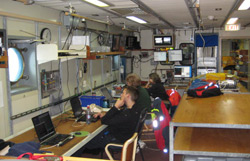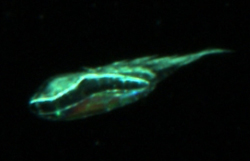Current? What Current? by Dallas Murphy
“Henry Stommel, the most original and important physical oceanographer of all time,” wrote his friend and former student Carl Wunsch, “entered oceanography [1944] when the field still had…the atmosphere of an avocation for wealthy amateurs who used their own yachts for research; he left it at a time [1992] when it had been transformed into a modern branch of science...” Oceanography is a young science because of “the brute difficulty of measuring the ocean.” (Wunsch) The ocean, so vast in three dimensions, so rough and variable, defied fine minds for centuries. Before World War II, there were few tools to measure the ocean much more sophisticated than a bucket, a thermometer, and a note in a bottle. But the World War and the ensuing Cold War changed that, when radar, sonar, and other legacies of strife passed into the hands of peaceable oceanographers. (In fact, in their original form, some of the tools aboard Knorr today were originally invented to hide our submarines or to kill Soviet submarines.) Let’s look at a few of today’s tools and devices. A year ago, Dr. Bob and the WHOI Buoy Group set eight “moorings” in the Irminger Sea, and the partial purpose of this trip is to recover the moorings and extract their data. A mooring is a long wire anchored to the bottom by a heavy cast-iron cylinder with a huge float at the top, but still well below the surface, to keep the wire straight. You can string various kinds of devices as needed along the wire. But on this trip, Bob is using a relatively new device called the Moored Profiler invented by a very clever scientist, John Toole, and “a host of engineers and techs here at WHOI,” as Dr. John put it. Here’s how it works: The profiler is a type of yellow hard-plastic pod housing a current meter, oxygen sensors, and a miniature conductivity-temperature-depth recorder (CTD). What’s new and unique about the Profiler is how it takes its measurements: It chugs continuously up and down the wire by means of a tiny traction motor. This is especially useful because it produces a continuous picture, a “profile” of the entire water column over a long stretch of time. By placing a string of moorings with Profilers astride the current, you can get full-depth coverage of a particular, pertinent area. But it also produces a level of anxiety in the oceanographer. Dr. Bob has been nervous all year about his profilers. The currents and storms in the Irminger are strong enough to lay the moorings over—“blow down”—despite 2,000 pounds of buoyancy in the top floats. And then there are gigantic drifting icebergs to rip out the moorings by the roots. And there are commercial fishermen towing bottom trawls. After all the work and expense of setting the moorings/Profilers, Bob might have come out here to find…nothing. Fortunately, the mooring guys have successfully recovered seven of the eight, which have returned precious data. Together, they have traveled vertically one million meters, or 650 miles. The eighth, up north of the Denmark Strait, will be (hopefully) recovered next week. Wish Dr. Bob luck. When several years ago I first went to sea on a research vessel, I couldn’t figure out how they recovered these things. Remember the top float is set dozens of meters beneath the surface; you can’t snatch it up with a boathook like a yacht-club mooring ball. But you can’t leave it on the surface to be run down by ships and icebergs. Oceanographers and engineers solved this problem with the “acoustic release.” It’s a set of jaws gripping the anchor at the bottom. You hang a transponder over the rail that “talks” to the release in sonic language, tells it first to wake up, and the release responds with pings saying, “Ready for instructions.” Another set of pings tell the jaws to open wide. And up comes the mooring to be hauled aboard. Brilliant, huh? We could go on for days about the tools of contemporary oceanography. Consider for now the Acoustic Doppler Current Profiler, or ADCP. Knorr has two ADCPs mounted in her bottom, and Bob placed lots of ADCPs on his moorings. You’ve probably heard the way the pitch of a fire-engine siren or locomotive changes as it passes. That’s the “Doppler shift.” The ADCP measures ocean currents directly by bouncing sound waves off of particles such as sediment and plankton drifting in the currents. The wave arrives back at the instrument with a slightly different frequency than the outgoing wave, and the difference tells you how fast the current is flowing. The ADCP is constantly pinging the depths, and raw data returns to computers in the lab, where Dan and Kjetil remove the speed of the ship from the data and otherwise refine it. We’ll talk more about the tools of the trade, but for now let’s mention a specialized device called a Video Plankton Recorder (VPR). Melissa, our biological oceanographer, who has just come inside (wet) after deploying and recovering her VPR, describes it as a combination camera and microscope. It photographs in high resolution any creature “caught” between the strobe light and the camera, and because that distance is short, that usually means tiny plankton. Closing, let’s point out that there are two basic methods of measuring a current. You can set an object adrift and somehow follow it, or you can fix an instrument(s) to the bottom or to a mooring and measure the passing current. It’s sort of like cinematography: You can follow the action with the camera or fix the camera and let the action flow past it. Irminger-p silaa ulluni kingullerni by Nick M?llerUllut kingulliit umiarsuarmiit paasisassarsiornigut assigiijakannersumik ingerlapput, taamatuttaaq sila ullut kingullit allannguuteqangaassanani anorlertuarsinnarpoq. Piffimmi titarniusaq sanimukaartoq 66° missaani imartaq misissuivigaarput, titarniusarlu ammukaartoq 30° - 20° akornani, tamaani imaq itisuujunngilaq meter – it 500 missiliorlugit itisussuseqarluni. Oqareernertuut sila allannguuteqangaarneq ajorpoq piffissami kingullermi, anoraa sakkortussuseralugu sakkortunerpaaffimmmini 20 m/sec. Silaannaap kiassusia eqqaassagaanni eqqumiiginarngajassinnaasumik nillernani isugutappoq, piffissammi taamaasinerani kitaata sineriaani silaannaa amerlanertigut nillertarmat panernerullunilu. Umiarsuup aquttarfiata silataani siorngatungaanilu aneerluni alutornarpoq, naak anoraa sakkortusisarsinnaagaluartoq immallu tarajuanik akoqarluni, silaannarittaqimmat ajorisassanngilaq. Qiviagarmi tamarmi samungarsuaq naaffeqanngiusattumik isikkoqarpoq, soorlu qanorluunniit killeqanngiusattumik ilummut anersaarsinnaalluni. Isikkivissuaq taamaattoq kiffaanngissuseqartutut misiginarpoq, sumulluunniimmi qiviagaq tamarmi aporfeqaranilu killilersugaanngilaq. Pingaartumik seqineq nualaarsimatillugu pinngortitarsuaq alutornavittarpoq, ullup ilangaatsiarsua ilaatigut maani avammut isiginnaarluta atorsinnaasarparput, nillerilersimagaangatsigulu aquttarfimmut kissassimaariartarluta. Umiarsuup aquttarfiani sulisut inussiarnersorsuupput, naak atortorissaarutimigut atortorissaaqisukkut ittoortutut misiginarsinnaagaluartoq, aquttuuneq ikiortailu oqaloqatigisarpagut akornusersuinaveersaarluta. Isiginnaagassiani aammami umiarsuarni allani takusartakkagut aquussuaq ammalortoq arlariinnik tigummivilik, maani aqattarfimmi taama aquummik ittumik takusassaqanngilaq. Umiarsuup aquttuunerata oqaatigaa aquutit pingaarnerit pingasut atortarlugit umiarsuq nakkutigineqartartoq, aquutai tamarmik aquummiit naliginnaasumiit allaanerusumik isikkoqarput, ataaseq joystick-imik taasartagaannik ittumik ilusilik takusinnaavarput, taakkulu saniatigut timmisartortartut aquutaanut assingusut aquutit takutillugit. Umiarsuaq siuliani taaneqareersutuut naliginnaasuunngilaq, unami umiarsuaq marlunnik sarpeqarpoq. Pisarnermisut umiarsuarni allani tamani sarpia siulleq aquaniippoq, sarpissiatalu aappaa siornaniippoq kaajallangajavilluni qivertinneqarsinnaqasoq. Imaannarsuarmi mallersumi umiarsuup aqussinnaanissaa, inissisimaffimmi aaliangersimasumi, sarpiit marluk taakku atorlugit qarasaasiakkut aaqqitamik uninngatseqqissarneqartarpoq. Aquttut aquutaa sanguterattaartariaqarneq ajorpaat tassami qarasaasiakkut qanoq ingerlanissaa qanorlu inissisimanissa, aaliangersoriarlugu qarasaasiap isumagisarpa umiarsuup ilisimatuunik misissuisoqartillugu, eqqartumik atoruminartumillu inissisimanissa. Angalalernitinniit umiarsuarmik akunissarput amerlasuutigut naatsersuutigisaraluarpara, maanimi kilisaatit aalisariutit arlallit aalisartarmata. Kiisimeerlunga ullumikkut ataaseq takuara, ungasimmat takusinnaanngilara sumiut aalisariutaatigineraat. Island – imiut Savalimmiormiut Kalaallillu tamaani aalisartarmata ilimanarpoq taakku nunat arlaannit aalisartuussasoq. Piffissami kingullermi imaani nalunaarsuutinik suliallit ulloq unnuarlu suliaqartarput, piffissamilu aggersumi CTD atorlugu imaani misissuinerit ingerlassallutik. Misissuinitsinni sumiiffipput paasissutissallu soqutiginartut arlallit takunearsinnaapput nittartakkami. Ullunilu aggersuni Tunup sinerassua qanilleqqittussaavarput, taamanikkornissaanut qilanaarnaqaaq. Tunummi sineriassua kusanartorsuummat takoqqissallugu alutornavippoq. Last updated: October 17, 2008 | |||||||||||||||||||||||||
Copyright ©2007 Woods Hole Oceanographic Institution, All Rights Reserved, Privacy Policy. | |||||||||||||||||||||||||


